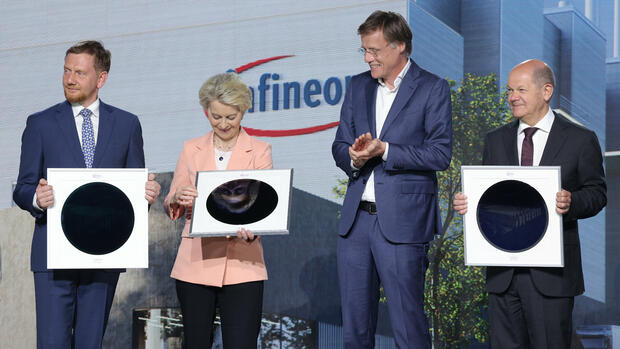Saxony’s Prime Minister Michael Kretschmar, EU Commission President Ursula von der Leyen, Infineon CEO Jochen Hanebeck and Federal Chancellor Olaf Scholz. The politicians hold so-called wafers in their hands, on which the chips are made.
(Photo: Getty Images)
Dresden. Europe’s race to catch up in chip production is progressing: This Tuesday, semiconductor manufacturer Infineon officially started building its most expensive factory to date. The Dax group puts five billion euros into its location in Dresden.
The plant is not only important for Infineon, but for the whole of Europe, said the President of the EU Commission, Ursula von der Leyen, at the groundbreaking ceremony: “We need more mass production of chips here again.” It is essential that the supply chains “of our to strengthen most important goods”.
>>Read here: Europe wants to become a leader again in semiconductors
The supply of the European industry with semiconductors is at risk because Europe relies too much on the important supplier countries South Korea and Taiwan. In view of the political tensions in this region, this is no longer an option.
Europe needs four times as many factories as it does today
However, it is also clear that Infineon’s new plant can only be the beginning of achieving the EU Commission’s goal: Europe’s share of global chip production is to more than double by 2030 – to 20 percent. And to do this, Europe would have to “quadruple its current capacity,” explained von der Leyen.
Infineon is expected to collect one billion euros in subsidies for the factory in Dresden. The new plant is scheduled to go into operation in 2026 and generate additional sales of five billion euros a year. This corresponds to a good third of the revenues of the past financial year. 1000 new jobs are to be created.
“The demand for semiconductors is growing strongly and permanently,” said Infineon CEO Jochen Hanebeck, explaining the billion-euro investment. For Europe, the plant in Saxony is important “to reduce one-sided dependencies”.
In fact, the Munich company has been growing dynamically for years, most recently Hanebeck raised its forecast for the current financial year. Sales should still be above the previously expected 15 to 16 billion euros. The operating margin will also be better than announced. Things are going well, especially in business with the automotive industry and in the industrial division.
On Tuesday, Infineon was the leader in the Dax with a price increase of more than three percent. The reason for this was surprisingly good figures from Dutch rival NXP.
Chancellor Olaf Scholz indicated in Dresden that another chip manufacturer could soon settle in Dresden. He was “confident that this was not the last major investment in Silicon Saxony,” said the SPD politician.
The Taiwanese contract manufacturer TSMC has been negotiating with both potential customers and the state about a factory in Saxony for more than a year. But no decision has been made yet. At the beginning of the year, the US group Wolfspeed decided to build a factory for power-saving chips made of silicon carbide in Saarland.
More: The Linux of chip design: A new standard is revolutionizing the semiconductor industry

